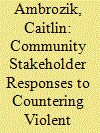| Srl | Item |
| 1 |
ID:
168390


|
|
|
|
|
| Summary/Abstract |
In the United States, despite federal efforts to empower communities to form local governance networks to develop and implement collaborative countering violent extremism (CVE) programs, local CVE governance networks are rare. Why do CVE governance networks emerge within only some communities? I argue that three factors—interest in CVE, capacity to participate, and facilitation—determine the prospects for the emergence of a CVE governance network within a community. The article uses a matching technique to identify and compare the community stakeholder responses to CVE in two communities—Houston, TX and Columbus, OH. Survey research of stakeholders who participated in Houston and stakeholders most likely to participate in Columbus but did not highlights the importance of the three factors. By focusing on these drivers of collaborative governance, the article provides an explanation for the lack of CVE collaboration in the United States.
|
|
|
|
|
|
|
|
|
|
|
|
|
|
|
|
| 2 |
ID:
168930


|
|
|
|
|
| Summary/Abstract |
Although government use of militias during civil conflict can ultimately undermine state authority, governments still use militias for battlefield assistance. This paper examines the selectivity of government decisions to use militias by disaggregating civil conflict to the level of battle phases. Civil-conflict battles typically consist of four phases: preparation, clear, hold, and build. I argue that governments decide to use militias based on the strength of government security forces, operational advantages of militias, and the type of battle phase. Governments will limit the use of militias during key battle phases that are likely to receive increased media attention unless a victory secured by government security forces is unlikely or militias hold an operational advantage. A comparative analysis of the offensive operations in Tikrit and Ramadi during Iraq’s war against the Islamic State of Iraq and Syria (ISIS) lends initial support to this theory.
|
|
|
|
|
|
|
|
|
|
|
|
|
|
|
|